Contents
Market Overview
Macro Review
Global markets are at the mercy of central bank headlines while global leaders, economic thinkers and policymakers gather in Davos to discuss themes with varied degrees of short-term market relevance. Markets performed well for the most part this week supported by soft U.S. economic data releases, perception that the European Central Bank (ECB) might be less hawkish than previously feared and continuation of the “China re-opening” narrative. In Japan, a dovish outcome was also risk supportive as the BoJ left all its policy tools unchanged despite increasing speculation about a change to its yield curve control policy. However, DM fixed income instruments gave back some gains toward the end of the week as a fresh wave of hawkish comments by Fed and ECB officials signaled that market perception about nearing “peak hawkishness” by systemic DM policymakers might be premature. Meanwhile, oil continued to rally with Brent prices moving to a YTD high of around $87/bbl. Against this backdrop, EM credit performed well, with total returns supported by UST yields that finished lower on the week and tighter spreads. Political headlines continue to dominate in Brazil and Turkey where investors focused on President Lula’s comments about central bank independence and President Erdogan’s increasing fiscal largesse ahead of crucial elections scheduled for mid-May. Argentina surprised markets by announcing plans to repurchase some of its 2029 and 2030 USD bonds, supporting valuations but raising concerns about further depletion of already pressured FX reserves.
EM Credit Update
Emerging market sovereign credit (cash bonds) ended the week 1.0% higher with spreads 5bp tighter. Corporate credit was +0.8% this week with spreads 3 bps tighter. Sovereign outperformers over the week were Sri Lanka, Tajikistan, and El Salvador, while Ethiopia, Pakistan, and Ghana underperformed.
The Week Ahead
Markets will be eagerly awaiting the Federal Reserve’s preferred measure of inflation, the core personal consumer expenditure (PCE) deflator due on Friday. Consensus expects 4.4% YoY and 0.3% MoM. In EM there will be a flurry of central bank policy rate decisions with Nigeria (+50bps expected), Thailand (+25bps), South Africa (+50bps), Ukraine (hold), Chile (hold) and Colombia (+100bps) on the docket. The second round of Presidential elections in the Czech Republic will take place at the end of next week in which both candidates favor closer relations with Europe and the West rather than with China/Russia.
Highlights from emerging markets discussed below: Argentina announces buyback as bonds extend rally and Lula’s comments about central bank independence highlight risks to economic policy management in Brazil that markets will be focused on this year.
Fixed Income
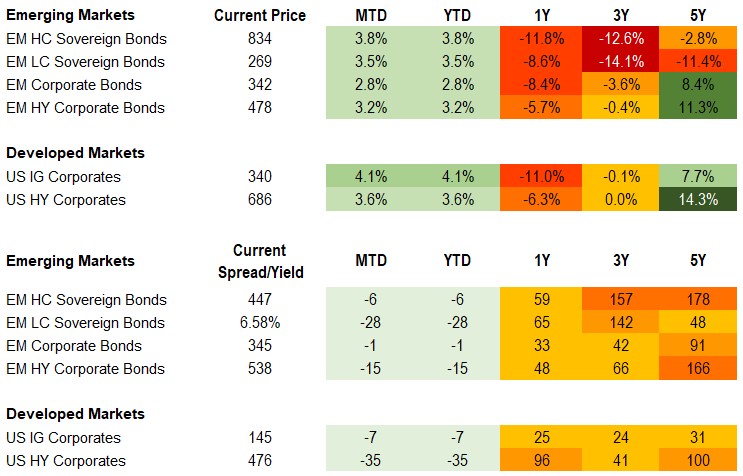
Equities
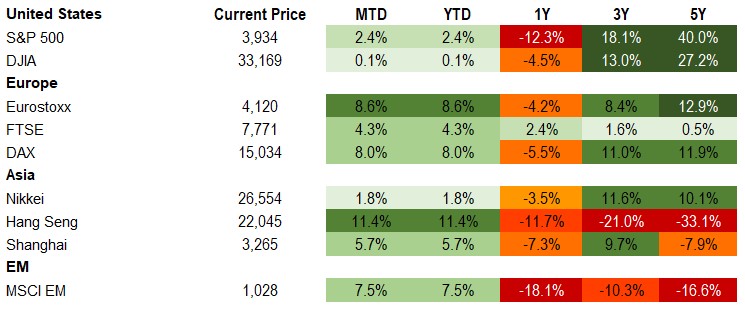
Commodities

Source for data tables: Bloomberg, JPMorgan, Gramercy. EM Fixed Income is represented by the following JPMorgan Indicies: EMBI Global, GBI-EM Global Diversified, CEMBI Broad Diversified and CEMBI Broad High Yield. DM Fixed Income is represented by the JPMorgan JULI Total Return Index and Domestic High Yield Index. Fixed Income, Equity and Commodity data is as of January 20, 2023 (mid-afternoon).
Emerging Markets Weekly Highlights
Argentina announces buyback as bonds extend rally
Event: Economy Minister, Sergio Massa, announced that the government would buyback $1bn of USD bonds with a focus on Global 2029s and 2030s albeit with uncertainty around the details of the operation. At the same time, the Treasury rolled over 120% of maturities in its latest tender raising ARS417bn (vs. ARS353bn due on Friday). USD bonds were up roughly 5pts on the week following the buyback news after a solid upward trajectory from their lows in 4Q.
Gramercy commentary: The intent to purchase dollar bonds came as a surprise to the markets given the still relatively strained net FX reserve position particularly in the context of the ongoing drought. Nevertheless, we see it as constructive for short-end bonds in the very near-term as it reiterates willingness to pay. We speculate there were likely political and economic incentives at play with a desire to continue to contain the gap between the parallel and official rates. Possibly related, the largely successful domestic rollover is also constructive in the near-term with continued focus on domestic demand as 2Q nears.
Lula’s comments about central bank independence highlight risks to economic policy management in Brazil that markets will be focused on this year
Event: Brazil’s newly elected President, Luiz Inacio Lula da Silva, publicly criticized the Central Bank of Brazil (BCB) during the first TV interview he gave after last week’s riots in the capital, Brasilia, by supporters of former President Jair Bolsonaro.
Gramercy commentary: Brazil’s Central Bank has been one of the EM institutions at the forefront of pragmatic monetary policymaking amid successive major economic shocks over the last several years. Aggressive pre-emptive policy tightening by the BCB has contributed to inflation pressures in Latin America’s largest economy likely peaking well ahead of most other EM peers and building a significant protective buffer for local-currency Brazilian assets in the form of high real interest rates. Under a scenario involving a sustained normalization of inflation dynamics during 2023, the BCB will likely be among the best positioned EM central banks to start easing policy by lowering interest rates and supporting growth in the second half of this year. This constructive backdrop for Brazilian assets is at risk of being delayed and/or watered down if comments on economic policy management such as the ones made by President Lula during his TV appearance this week persist and, especially, if they start being translated in actual policy measures/actions. Markets have grown increasingly concerned about the direction of fiscal policy under the Lula Administration since the October 2022 elections and will likely be extra sensitive going forward to signs that the government could attempt to put pressure on central bank policy management or question legislation granting BCB formal autonomy that was approved back in early 2021 under the previous Bolsonaro Administration.
Emerging Markets Technicals
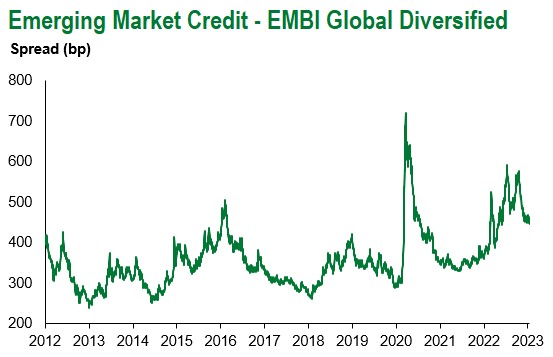
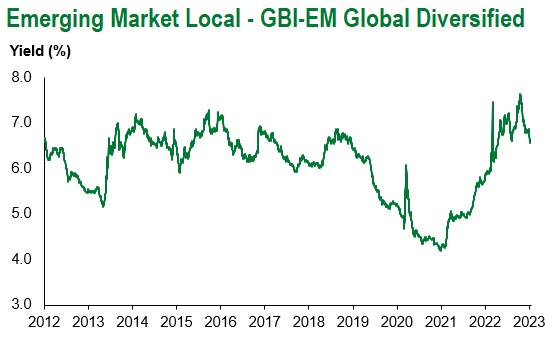
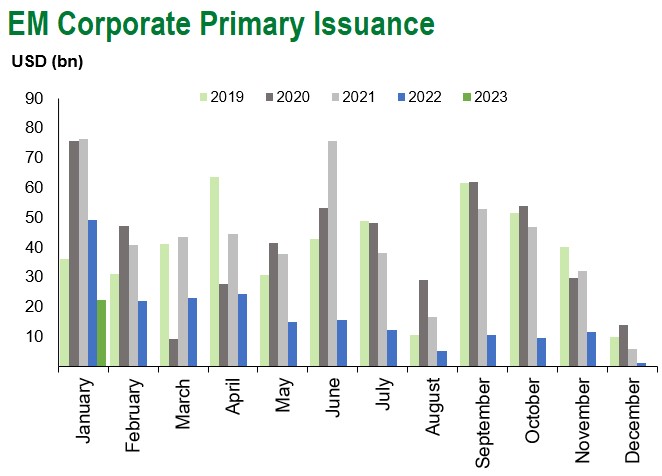
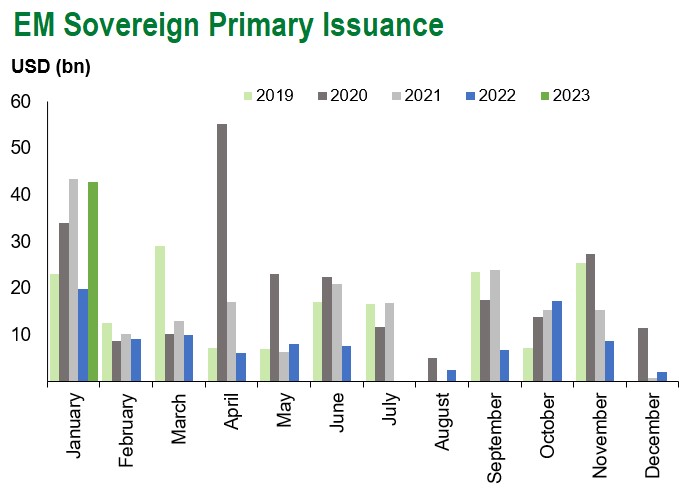
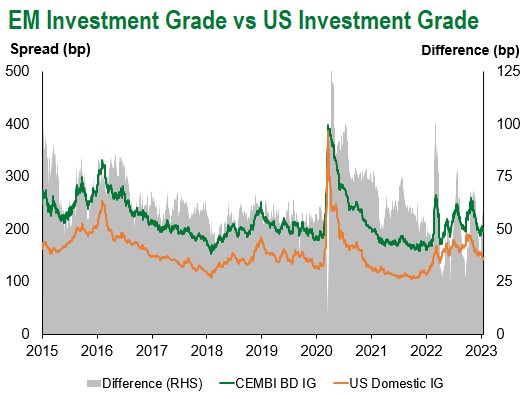
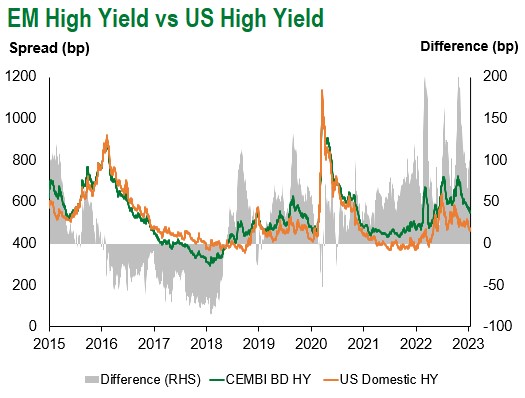
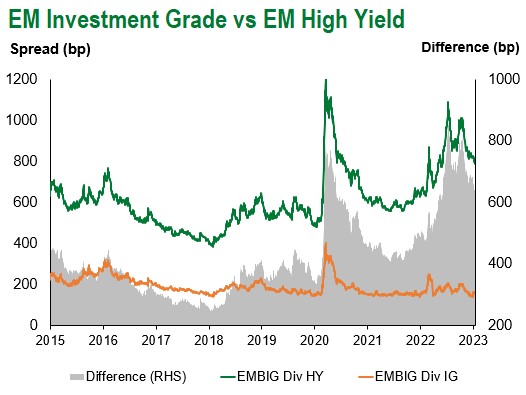
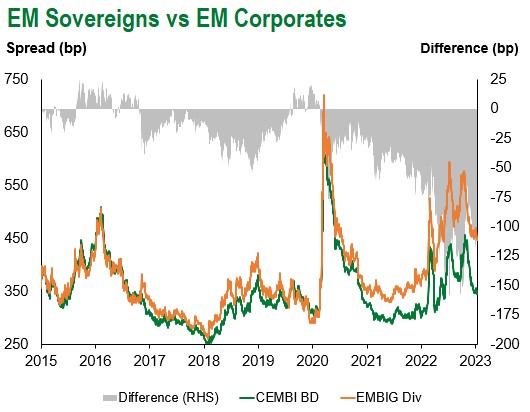
Emerging Markets Flows
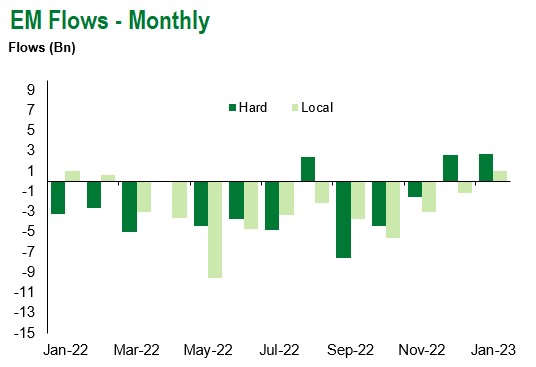
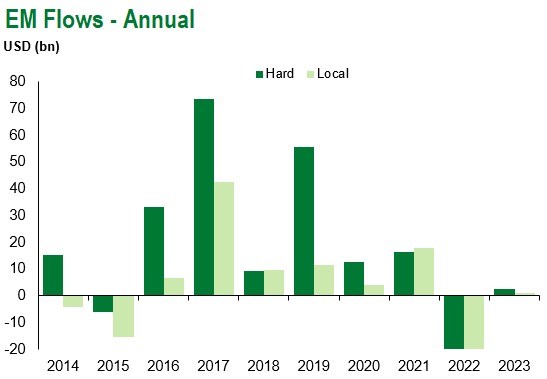
Source for graphs: Bloomberg, JPMorgan, Gramercy. As of January 20, 2023.
COVID Resources:
Johns Hopkins COVID-19 Case Tracker
For questions, please contact:
Kathryn Exum, CFA ESG, Director, Co-Head of Sovereign Research, [email protected]
Petar Atanasov, Director, Co-Head of Sovereign Research, [email protected]
James Barry, Director, Deputy Portfolio Manager, [email protected]
This document is for informational purposes only. The information presented is not intended to be relied upon as a forecast, research or investment advice, and is not a recommendation, offer or solicitation to buy or sell any securities or to adopt any investment strategy. Gramercy may have current investment positions in the securities or sovereigns mentioned above. The information and opinions contained in this paper are as of the date of initial publication, derived from proprietary and nonproprietary sources deemed by Gramercy to be reliable, are not necessarily all-inclusive and are not guaranteed as to accuracy. This paper may contain “forward-looking” information that is not purely historical in nature. Such information may include, among other things, projections and forecasts. There is no guarantee that any forecasts made will come to pass. Reliance upon information in this paper is at the sole discretion of the reader. You should not rely on this presentation as the basis upon which to make an investment decision. Investment involves risk. There can be no assurance that investment objectives will be achieved. Investors must be prepared to bear the risk of a total loss of their investment. These risks are often heightened for investments in emerging/developing markets or smaller capital markets. International investing involves risks, including risks related to foreign currency, limited liquidity, less government regulation, and the possibility of substantial volatility due to adverse political, economic or other developments. References to any indices are for informational and general comparative purposes only. The performance data of various indices mentioned in this update are updated and released on a periodic basis before finalization. The performance data of various indices presented herein was current as of the date of the presentation. Please refer to data returns of the separate indices if you desire additional or updated information. Indices are unmanaged, and their performance results do not reflect the impact of fees, expenses, or taxes that may be incurred through an investment with Gramercy. Returns for indices assume dividend reinvestment. An investment cannot be made directly in an index. Accordingly, comparing results shown to those of such indices may be of limited use. The information provided herein is neither tax nor legal advice. Investors should speak to their tax professional for specific information regarding their tax situation.
